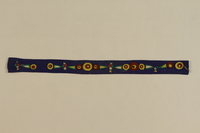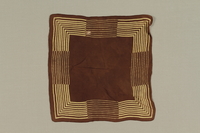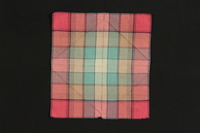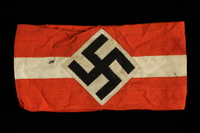Overview
- Brief Narrative
- SA [Sturmabteilung] brown uniform shirt with swastika armband brought back from the war by Harry Meyerowitz, a soldier in the US Army in Europe from 1944-1945. It has the official tag of the RZM, the National Equipment Quartermaster. The collar insignia indicates a rank of SA - Rottenfuhrer, a Troop leader for a paramilitary squad of 5-7 men. The green collar tab number 133, was for Gruppe Sachsen, which was located in Saxony, Germany, from 1933 until May 1945. The SA was a Nazi paramilitary organization. Known as Brownshirts or Storm Troopers, the SA protected Nazi leaders, marched in Nazi rallies, and terrorized political opponents during Hitler’s rise to power. By 1933, SA membership had expanded to nearly three million men. It lost most of its political power to the SS after a 1934 purge. Harry deployed to Europe in 1944. His unit entered Ohrdruf concentration camp on April 6, 1945, two days after its liberation by US troops. This was the first camp liberated by American forces. Ruth Krautwirth, her parents Hanna and Isak, and brother Zev were deported from Frankfurt, Germany, to Birkenau in April 1943. Ruth and Hanne, separated from Isak and Zev, were together through Birkenau, Ravensbrück, and Malchow, and were liberated on a death march by US troops in May 1945. Zev survived Birkenau, Sachsenhausen, Gunskirchen, and Mauthausen, and then went to Palestine. Several of Ruth’s relatives were killed in the Holocaust. Her father Isak, 46, was killed in Auschwitz on November 19, 1943. Her maternal grandfather and cousins also were killed. Ruth and Hannah left for America in 1947, where Ruth and Harry met, and then married in 1948.
- Date
-
found:
approximately 1945-before 1945 November
manufacture: after 1934-before 1945
- Geography
-
manufacture:
Ludenscheid (Germany)
- Credit Line
- United States Holocaust Memorial Museum Collection, Gift of Ruth Meyerowitz
- Markings
- left collar tab, embroidered, white thread : 29/133
button backs, maker’s mark, engraved : RZ / M / M5 / 72 [Reichszeugmeisterei inspection mark / uniform accessories category / Paul Cramer & Co.]
belt hooks, maker’s mark, engraved : RZ / M M5 / 8 [Reichszeugmeisterei inspection mark / uniform accessories category / F.W. Assman & Son] - Contributor
-
Subject:
Harry Meyerowitz
Subject: Ruth K. Meyerowitz
Manufacturer: Paul Cramer & Co.
Manufacturer: F.W. Assman & Son
- Biography
-
Harry Meyerowitz was born on June 24, 1921, in Passaic, New Jersey, to Benjamin and Esther Meyerowitz. He had three siblings. Harry worked as a furrier. On December 8, 1941, following the attack on Pearl Harbor, the United States entered World War II. On August 28, 1942, Harry enlisted in the US Army. On April 6, 1945, Harry and his unit entered Ohrdruf concentration camp in Germany, following its April 4 liberation by the US 4th Armored Division. Ohrdruf was the first concentration camp liberated by American forces. Harry was discharged from the army on November 10, 1945. He finished school under the GI bill and worked as an accountant. On December 5, 1948, Harry married Ruth Meyerowitz, who was born on June 23, 1929, in Frankfurt, Germany. She survived imprisonment in Auschwitz, Ravensbrück, and Malchow concentration camps. Harry disliked his desk job and he and Ruth began a furrier business in 1949. Harry and Ruth had three sons. Harry, age 65, died on August 28, 1986, in Fair Lawn, New Jersey.
Ruth Krautwirth was born on June 23, 1929, in Frankfurt, Germany, to Yitzhak (Isak) and Hanna Bina Grossman Krautwirth. She had one brother, Wolfgang (Zev), born on May 16, 1933. Her father Isak was born May 27, 1897, in Bardejov, Austro-Hungary (now Slovakia), to Yaakov and Rose Wertheim Krautwirth. The family immigrated to Germany in 1899. Isak had two brothers, Julius and Aba, and an older sister. Isak served in the Austrian Army in World War I (1914-1918). Ruth’s mother Hanna was born April 7, 1900, in Kamienna, Russia (Skarzysko-Kamienna, Poland), to Joseph and Gitel Grossman. Hanna had two sisters, Cyma and Bella. Isak and Hanna married in 1927. They owned a leather goods manufacturing business. The family kept kosher and observed Shabbat.
In January 1933, Hitler came to power and, by summer, Germany was ruled by a Nazi dictatorship that actively persecuted Jews. Ruth’s maternal grandmother Gitel died later that year. Ruth attended the Philanthropin school, a progressive, private Jewish school. She noticed gradually increasing instances of anti-semitism. She often walked in the gutters because Jews had to make way for Germans walking on the sidewalks. Ruth’s parents told her she was no longer allowed to play with non-Jewish children. In 1936, Ruth’s paternal uncle Aba went to Palestine. Isak’s business was taken away and given to a non-Jewish dentist. The dentist did not know anything about the business so Isak continued to work there. When the dentist questioned Isak about the business, he kept a gun on his desk for intimidation. Following the Kristallnacht pogrom on November 9 and 10, 1938, Ruth’s teachers tried to act like everything was normal, but the number of students and teachers fluctuated as Jews disappeared or moved into Frankfurt from smaller towns. In 1939, the family learned that Ruth’s paternal uncle Julius had been killed. A journalist, he had fled to Czechoslovakia after the Nazis came to power. He was caught and executed after the German invasion of Czechoslovakia in March 1939. Ruth and her family attempted to flee to France, but the borders were closed. On September 1, 1939, Germany invaded Poland, starting World War II. In 1941 and 1942, thousands of Jews were deported from Frankfurt, including Ruth’s best friend, Irma Stern. They were told that they were being resettled in the east. Ruth’s father Isak was a Czech citizen an for a while, this protected the family from deportation. In 1942, Ruth’s school was closed. Her family was forced to leave their home and move into an old orphanage. They lived in one room and only Isak was permitted to leave to go to work.
In April 1943, Ruth’s family was told that they were being resettled in the east. Isak was given the option of staying in Frankfurt to continue working at the leather factory, but he chose to go with his family. They agreed that if they were separated, they would meet again in Frankfurt. On April 19, they were taken to the train station, where Ruth, Hanna, and Zev were separated from Isak. They arrived in Auschwitz-Birkenau after seven days on a passenger train. Ruth looked for her father on the platform but could not find him. Ruth, Hanna, and Zev were taken into a room, where they stripped and their heads were shaved. Ruth was tattooed with prisoner number 42716, Hanna with 42715, and Zev with 117942. They were given filthy, ill-fitting civilian clothing. The next day, they were assigned to work flattening the road with sand and a large grater. They were later given striped prisoner uniforms and assigned to work in the potato fields. After a few weeks, the guards decided it was not appropriate for Zev to remain in the women’s barrack and he was taken away. They got very little food and nearly everyone had festering sores due to malnutrition and the unsanitary conditions. In summer 1943, Ruth became ill with typhus. There was a selection and Ruth was selected to go to the gas chambers. The prisoner in charge of the barracks intervened and snuck Ruth back into the barracks where she eventually recovered. Ruth became close friends with Nini Benmajor, a singer from Greece. A guard wanted Nini to live with him, but she refused. A few days later, Nini was sent to the gas chambers. In winter 1943, Ruth and Hanna were assigned to work at a weaving factory, braiding strips of cellophane. In fall 1944, they were assigned to work at the Kanada warehouse, where they sorted the belongings confiscated from inmates they assumed had all been murdered. It was a good job, because sometimes they found food. One day, Ruth found a book Nathan the Wise, but was caught reading it by a guard who boxed her ear until she was dizzy. Another day, they found a dead infant in a bundle of clothing. After a couple weeks, Ruth and Hanna were selected to go to Germany as slave laborers. On November 3, they were taken to Ravensbrück concentration camp. Ruth was assigned prisoner number 82349 and Hanna number 82348. They were put in a large tent and given no food or water. In late 1944, Ruth and Hanna were transferred to Malchow labor camp. They worked in a munitions factory, where Ruth made bullets. As the war came to an end, the guards stopped feeding the prisoners. They rioted and stormed the food storage area. In spring 1945, they were sent on a forced march for seven or eight days. In early May, Ruth and Hanna were liberated by American troops near the Elbe River.
The liberated prisoners were given care packages from the Red Cross. Hanna became ill from eating the food and was hospitalized. Ruth and Hanna stayed in a tent camp run by the British army. In the fall, they returned to Frankfurt to find Isak and Zev. They learned that Zev had survived imprisonment in Birkenau, Sachsenhausen, Gunskirchen, and Mauthausen concentration camps. He went to Palestine with the Palestinian contingent of the British Army. Hanna believed that Isak was killed in Auschwitz, but Ruth could not accept that her father was dead. In late 1946, they received visas to emigrate to the United States. Ruth persuaded Hanna to wait until the last possible ship in the hope that Isak would return. Several of Ruth’s relatives were killed in the Holocaust. Her father Isak, age 46, was killed in Auschwitz on November 19, 1943. Her maternal grandfather and cousins were killed. Ruth’s aunt Cyma emigrated to Montevideo, Uruguay, and her aunt Bella went to Canada. Ruth and Hanna sailed from Bremen on the SS Marine Marlin on February 21, 1947, arriving in New York on March 3. They moved to New Jersey, where Hanna worked at a nursing home and Ruth was a laboratory technician. Hanna changed her name to Hannah. On December 5, 1948, Ruth married Harry Meyerowitz (1921-1986), a soldier from Passaic, New Jersey, who was a liberator of Ohrdruf concentration camp. The couple settled in New Jersey and had three sons. In 1949, they opened a furrier business. Ruth received her BA in history and MA in literature. She was active early on in Holocaust remembrance events, having noticed how survivors were often treated as if their experiences did not matter and that they somehow were still not equal human beings. She lectured often and wrote about Holocaust history, partly as a warning to the world, trying to say: "This is what happened. Beware, don't fall into this sort of inhumanity." Hannah, age 85, died in December 1985, in Fair Lawn, New Jersey. Ruth, age 79, passed away on February 3, 2009, in West Orange, New Jersey.
Physical Details
- Language
- German
- Classification
-
Clothing and Dress
- Category
-
Military uniforms
- Object Type
-
Blouses (military jackets) (aat)
- Genre/Form
- Uniforms
- Physical Description
- Long sleeved, light brown cloth shirt with collar tabs, shoulder straps, a red swastika armband, and French cuffs. It is waist length with elasticized sides, a cloth belt loop, and 5 gold painted metal belt hooks inserted along the bottom, which keep the shirt hem down and taut. The front opening placket has 5 buttonholes and 5 silver colored metal shank buttons with rings attached inside; this placket has a gray protective cloth cover. There are 2 large bellows breast pockets with angled corners, a central pleat, and a flap with a silver colored metal button and a ring. The collar has green and white twisted cord trim, on the left collar is a green collar tab with 2 white ribbons flanking a green stripe and on the right is a green collar tab with split stitched numbers. The right shoulder has a green wool shoulder strap with green and white cord attached to a silver colored metal button. The collar ends have snap closures on the back to hold it upright as a standing collar. The red cloth armband sewn to the left upper arm has a white cloth circle with a woven black mobile swastika. The interior upper back is lined with gray cloth. The interior neckband has a brown cloth hanging loop and a white tag. There are red embroidered initials, KH, on the inside left breast.
- Dimensions
- overall: Height: 21.000 inches (53.34 cm) | Width: 19.500 inches (49.53 cm)
- Materials
- overall : cloth, metal, wool, cord, plastic, cord, thread, rubber
- Inscription
- interior, right breast, embroidered, red thread : KH
interior, cloth tag, white and green thread : DRGM / Für unsere / braunen / Kämpfer / Geschutzter Uniformkragen [Deutsches Reichsgebrauchsmuste German Nationally Registered Design / For our / brown / fighter / Protected Uniform Collar]
Rights & Restrictions
- Conditions on Access
- No restrictions on access
- Conditions on Use
- No restrictions on use
Keywords & Subjects
Administrative Notes
- Legal Status
- Permanent Collection
- Provenance
- The SA shirt was donated to the United States Holocaust Memorial Museum in 1988 by Ruth Meyerowitz, the wife of Harry Meyerowitz.
- Funding Note
- The cataloging of this artifact has been supported by a grant from the Conference on Jewish Material Claims Against Germany.
- Record last modified:
- 2024-01-18 08:43:14
- This page:
- https://collections.ushmm.org/search/catalog/irn817
Also in Harry and Ruth Krautwirth Meyerowitz collection
The collection consists of a belt and two handkerchiefs relating to the experiences of Ruth Krautwirth, who was an inmate of Auschwitz, Ravensbruck, and Malchow concentration camps during the Holocaust, and a Nazi armband and SA uniform shirt relating to the experiences of Harry Meyerowitz, a soldier in the United States Army in Europe during World War II.
Date: 1942 August-1945 November

Blue felt belt with appliqued flowers found by a German Jewish teenage inmate at Auschwitz
Object
Floral appliqué belt issued or found by 14 year old Ruth Krautwirth upon her April 1943 arrival at Auschwitz-Birkenau concentration camp, when her clothes were taken and she was given filthy, ill-fitting civilian clothing to wear. As Ruth recalled: "We endured at the edge of the crematoria. One day, very early on, I found a felt belt. A happy row of flowers on a blue field. Obviously the cheerful work of a child. ...I used the belt to cinch the waistline of my striped prison uniform. I bloused the top to hide the belt or I would have risked a beating. The button closing is long gone. Somewhere I found a rusty safety pin. It has remained there ever since. ...As starvation progressed, my clothes became looser with every day. To assuage my mother, I explained - not very convincingly - that instead of getting thinner, the belt actually stretched. Wearing this forbidden piece of finery was my pathetic act of defiance. I am still proud of it." Ruth, her parents Hanna and Isak, and brother Zev, 10, were deported from Frankfurt, Germany, to Birkenau in April 1943. Ruth and Hanna, separated from Isak and Zev, were together through Birkenau, Ravensbrück, and Malchow, and were liberated on a death march by US troops in May 1945. Zev survived Birkenau, Sachsenhausen, Gunskirchen, and Mauthausen and then went to Palestine. Several of Ruth’s relatives were killed in the Holocaust. Her father Isak, age 46, was killed in Auschwitz on November 19, 1943. Her maternal grandfather and cousins also were killed. Ruth and Hannah left for America in 1947.

Brown and yellow striped silk handkerchief found by a German Jewish teenage inmate at Birkenau
Object
Brown silk handkerchief with yellow lines found by 14 year old Ruth Krautwirth in Auschwitz-Birkenau concentration camp, where she was held from April 1943 to November 1944. Ruth worked in the Kanada unit, sorting the inmates discarded belongings. It is likely that she found the kerchief there. She kept the handkerchief "as a reminder that once there was a world without gassings, without filthy latrines and flea infested straw cots, without electrically charged wire fences." Ruth, her parents Hanna and Isak, and brother Zev were deported from Frankfurt, Germany, to Birkenau in April 1943. Ruth and Hanna, separated from Isak and Zev, were together through Birkenau, Ravensbrück, and Malchow, and were liberated on a death march by US troops in May 1945. Zev survived Birkenau, Sachsenhausen, Gunskirchen, and Mauthausen, and then went to Palestine. Several of Ruth’s relatives were killed in the Holocaust. Her father Isak, age 46, was killed in Auschwitz on November 19, 1943. Her maternal grandfather and cousins also were killed. Ruth and Hannah left for America in 1947.

Colorful plaid handkerchief found by a German Jewish teenage inmate at Birkenau
Object
Orange, pink, yellow, and green plaid handkerchief found by 14 year old Ruth Krautwirth in Auschwitz-Birkenau concentration camp, where she was held from April 1943 to November 1944. Ruth worked in the Kanada unit, sorting the inmates discarded belongings. It is likely that she found the kerchief there. She kept the handkerchief as a reminder "that once there was a world without gassings, without filthy latrines and flea infested straw cots, without electrically charged wire fences." Ruth, her parents Hanna and Isak, and brother Zev were deported from Frankfurt, Germany, to Birkenau in April 1943. Ruth and Hanna, separated from Isak and Zev, were together through Birkenau, Ravensbrück, and Malchow, and were liberated on a death march by US troops in May 1945. Zev survived Birkenau, Sachsenhausen, Gunskirchen, and Mauthausen, and then went to Palestine. Several of Ruth’s relatives were killed in the Holocaust. Her father Isak, 46, was killed in Auschwitz on November 19, 1943. Her maternal grandfather and cousins also were killed. Ruth and Hannah left for America in 1947.

Hitler Youth armband with a swastika acquired by a US soldier
Object
Hitler Youth armband acquired by Harry Meyerowitz, a soldier in the US Army in Europe from 1944-45. The Hitler Youth was founded by the Nazi Party to shape the beliefs and actions of German youth to conform to national socialist ideology. It was a pathway for service in the armed forces or, later, in the SS. In 1936, membership in Nazi youth groups became mandatory for those age ten to seventeen. Harry deployed to Europe in 1944. His unit entered Ohrdruf concentration camp on April 6, 1945, two days after its liberation by US troops. This was the first camp liberated by American forces. Ruth Krautwirth, her parents Hanna and Isak, and brother Zev were deported from Frankfurt, Germany, to Auschwitz-Birkenau in April 1943. Ruth and Hanne, separated from Isak and Zev, were together through Birkenau, Ravensbrück, and Malchow, and were liberated on a death march by US troops in May 1945. Zev survived Birkenau, Sachsenhausen, Gunskirchen, and Mauthausen, and then went to Palestine. Several of Ruth’s relatives were killed in the Holocaust. Her father Isak, 46, was killed in Auschwitz on November 19, 1943. Her maternal grandfather and cousins also were killed. Ruth and Hannah left for America in 1947, where Ruth and Harry met, and then married in 1948.
Book
Object
Short history on the persecution of Jews in Denmark and Norway, and the Danish underground refugee service.
Exhibition catalog
Object




